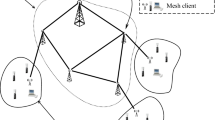Abstract
HiperLAN/2 (HIgh PErformance Radio Local Area Network) is a new standard from ETSI (European Telecommunications Standards Institute) for high-speed wireless LANs, interconnecting portable devices to each other and to broadband core networks, based on different networking technologies such as IP, ATM, IEEE 1394, and others. This paper introduces the basic features of the HiperLAN/2 MAC protocol. It presents performance evaluation results, specifically related to the mechanisms provided by HiperLAN/2 to manage bandwidth resource requests and granting. These results are assessed in terms of their flexibility and efficiency in supporting delay sensitive traffic, such as voice and Web data traffic, which are expected to be transported by broadband wireless LANs.
Similar content being viewed by others
References
G. Anastasi, L. Lenzini, E. Mingozzi, A. Hettich and A. Krämling, MAC protocols for wideband wireless local access: Evolution toward wireless ATM, IEEE Pers. Commun. 5 (1998) 53-64.
G. Anastasi, L. Lenzini and E. Mingozzi, HIPERLAN/1MAC protocol: Stability and performance analysis, IEEE J. Select. Areas Comm. 16 (2000) 1787-1798.
P.T. Brady, A model for generating ON-OFF speech patterns in twoway conversation, Bell Syst. Tech. J. (1969) 2445-2472.
G. Colombo, L. Lenzini, E. Mingozzi, B. Cornaglia and R. Santaniello, Performance evaluation of PRADOS: A scheduling algorithm for traffic integration in a wireless ATMnetwork, in: Proc. ACMMOBICOM' 99, Seattle, WA, August 1999, pp. 143-150.
J. Dunlop et al., Performance of statistically multiplexed access mechanisms for a TDMA radio interface, IEEE Personal Communications 2 (1995) 56-64.
ETSI TR 101 683: Broadband Radio Access Networks (BRAN), High PErformance Radio Local Area Networks (HiperLAN) Type 2, System Overview.
ETSI TS 101 761-1: Broadband Radio Access Networks (BRAN), HiperLAN Type 2, Data Link Control (DLC) Layer, Part 1: Basic Data Transport Functions.
ETSI TS 101 761-2: Broadband Radio Access Networks (BRAN), HiperLAN Type 2, Data Link Control (DLC) Layer, Part 2: Radio Link Control Protocol Basic Functions.
ETSI TS 101 761-4: Broadband Radio Access Networks (BRAN), HiperLAN Type 2, Data Link Control (DLC) Layer, Part 4: Extensions for Home Environment.
IEEE 802.11, Wireless LAN Medium Access Control (MAC) and Physical Layer (PHY) specifications, Standard, IEEE, New York, November 1997.
IEEE 802.11a, High-speed Physical Layer in the 5 GHZ Band, Standard, IEEE, New York, September 1999.
H. Li et al., Automatic Repeat Request (ARQ) Mechanism in Hiper-LAN/2, VTC 2000-Spring, Tokyo, May 2000.
N.M. Mitrou, Th. Orinos and E.N. Protonotarios, A reservation multiple access protocol for microcellular mobile-communications systems, IEEE Trans. Veh. Technol. 4 (1990) 340-351.
S. Nanda, D.J. Goodman and U. Timor, Performance of PRMA: A packet voice protocol for cellular systems, IEEE Trans. Veh. Technol. 5 (1991) 584-598.
K. Pahlavan, A. Zahedi and P. Krishnamurty, Wideband local access: Wireless LAN and wireless ATM, IEEE Commun. Mag. 11 (1997) 34-40.
V. Paxson and S. Floyd, Wide area traffic: The failure of poisson modeling, in: Proc. SIGCOMM' 94, London, UK, 31 August-2 September 1994, pp. 257-268.
Author information
Authors and Affiliations
Rights and permissions
About this article
Cite this article
Mingozzi, E. QoS Support by the HiperLAN/2 MAC Protocol: A Performance Evaluation. Cluster Computing 5, 145–155 (2002). https://doi.org/10.1023/A:1013981509844
Issue Date:
DOI: https://doi.org/10.1023/A:1013981509844




